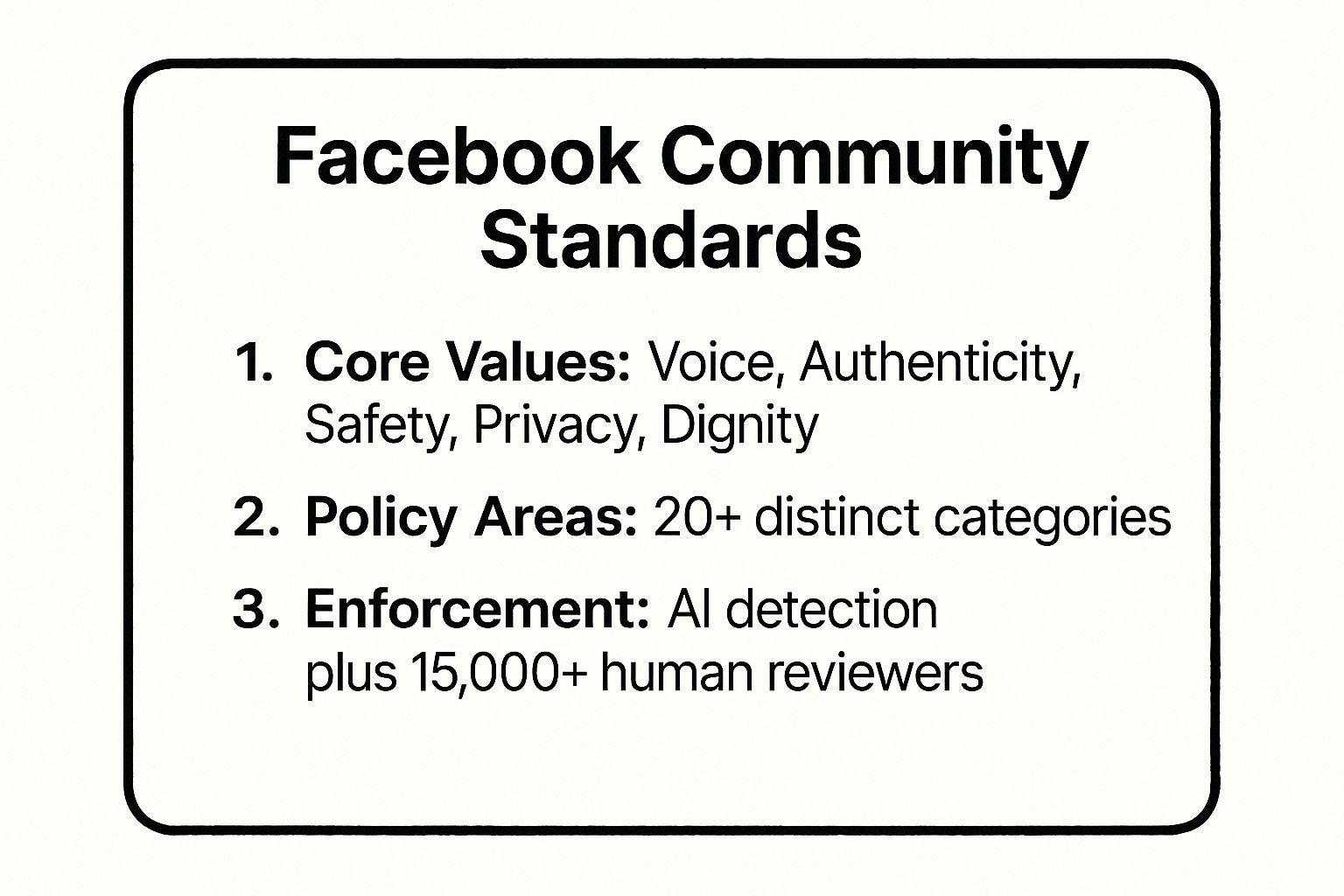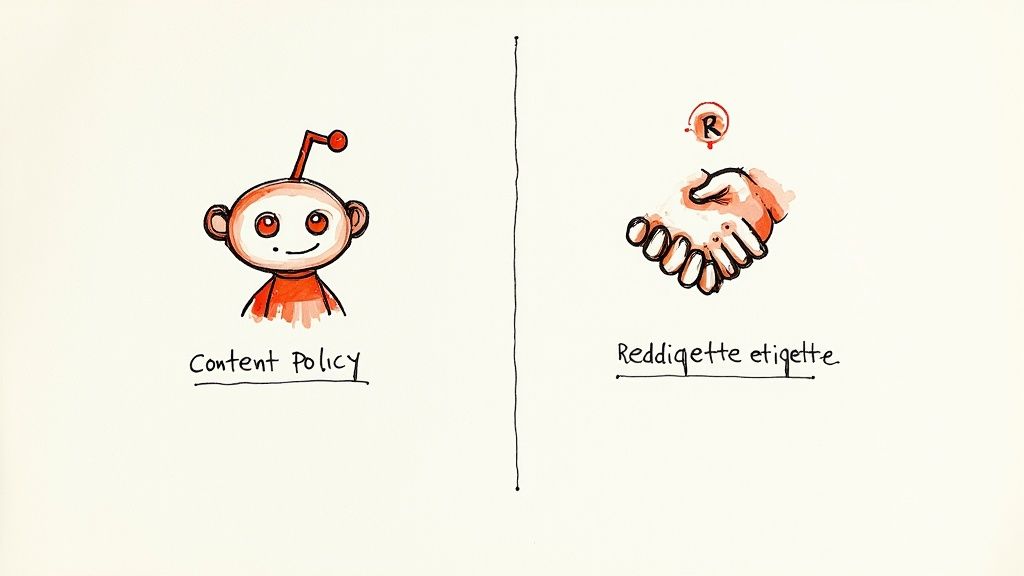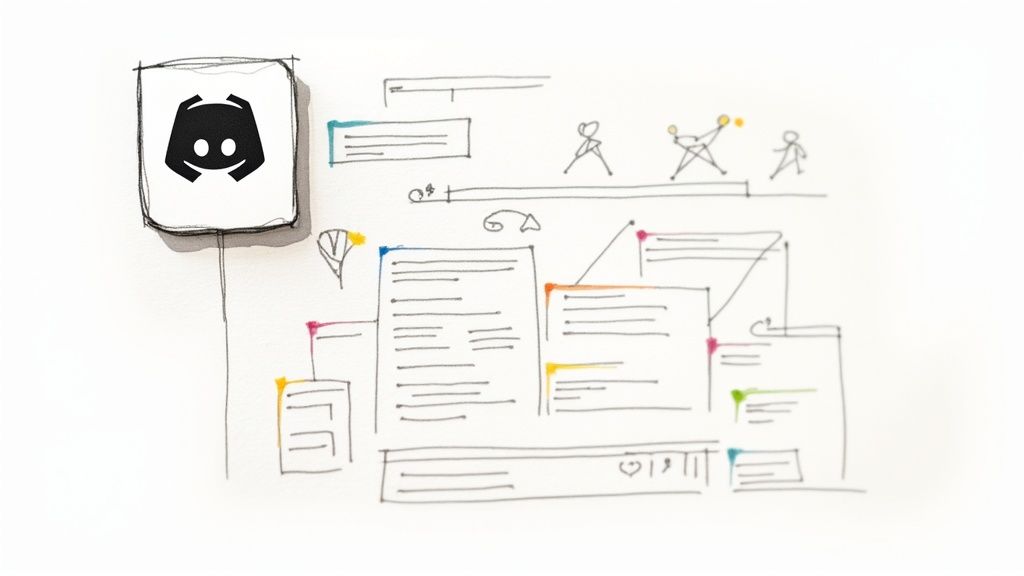October 19, 2025

Every successful online community, from sprawling social networks to niche forums, is built on a foundation of clear rules. These aren't just restrictive policies; they are the blueprint for a safe, engaging, and productive environment. Well-crafted community guidelines set expectations, prevent conflict, and empower members to interact with confidence.
But where do you start? Instead of reinventing the wheel, the most effective approach is to learn from the platforms that moderate billions of interactions daily. This article dissects eight powerful community guidelines examples from the world's leading platforms, including Reddit, Discord, and Facebook.
We will move beyond surface-level descriptions to provide a deep strategic analysis of what makes each one work. You will learn not only what their rules are, but why they are structured that way and the specific tactics they use to enforce them.
Get ready to uncover replicable strategies and actionable takeaways. Our goal is to provide you with the insights needed to transform your community's foundation from ambiguous to authoritative, whether you're managing a corporate network or a passionate hobbyist group. We'll show you how to adapt these proven methods for your own platform.
As one of the largest social networks globally, Meta's Facebook Community Standards represent one of the most comprehensive and influential community guidelines examples available. These guidelines are designed to create a safe environment across both Facebook and Instagram by clearly defining what is and isn't allowed. The standards cover a vast range of issues, from immediate threats like violence and incitement to complex challenges like misinformation and hate speech.
Facebook’s approach is a masterclass in scaling content moderation for a global audience. It relies on a sophisticated, multi-layered enforcement system. This system combines proactive AI detection, which flags potentially violating content, with a massive team of human reviewers who handle nuanced cases and appeals. This dual approach allows them to manage billions of pieces of content daily while still attempting to account for cultural context and intent.
The strength of Facebook's standards lies in their tiered structure and commitment to transparency. Policies are organized into clear categories, such as "Violence and Criminal Behavior" or "Safety," each with detailed explanations and specific examples of violations. This clarity helps users understand the rules and sets clear expectations.
Furthermore, Meta publishes regular transparency reports detailing content enforcement actions. This practice, along with the establishment of an independent Oversight Board for appealing high-profile decisions, is a strategic move to build public trust and demonstrate accountability, which is crucial for any platform operating at this scale. For those managing large online spaces, understanding these complex dynamics is vital, and you can learn more about the intricacies of social media community management.
The infographic below summarizes the core pillars of Facebook's content moderation strategy.

This data highlights the massive investment in both policy development and human-led enforcement required to maintain community integrity on a global scale.
Reddit's model provides a fascinating example of decentralized community governance. It operates on a unique two-tier system: a universal Content Policy that sets mandatory, site-wide rules against behaviors like harassment and illegal content, and Reddiquette, an informal, value-based guide encouraging positive user conduct. This layered approach creates a baseline for safety while empowering individual communities, or "subreddits," to develop their own specific rules and cultural norms.
This framework allows for immense customization. A subreddit like r/AskHistorians can enforce incredibly strict rules requiring in-depth, sourced answers, while a humor-based community might have more relaxed guidelines. This balance between top-down authority and bottom-up autonomy is what allows Reddit to host thousands of diverse and highly specialized communities under one roof. The platform's administration steps in to enforce the Content Policy, as seen with the 2020 ban of subreddits like r/The_Donald for repeated violations.

The genius of Reddit's strategy is its scalability through delegation. Instead of a centrally managed moderation team for all content, it empowers volunteer moderators within each subreddit. This distributed responsibility fosters a strong sense of ownership and allows moderation to be highly contextual and specific to each community's purpose. The platform provides the tools and the foundational rules, but the communities themselves handle the day-to-day enforcement.
This model also distinguishes between "hard" rules (the Content Policy) and "soft" recommendations (Reddiquette). This distinction helps users understand the difference between actions that will get them banned platform-wide and behaviors that are simply frowned upon by the community. To understand the enforcement of these policies, particularly concerning content moderation, one could investigate the intricacies of Reddit content removal processes, which often involve a combination of admin action and moderator intervention.
Discord's guidelines are a prime example of balancing user autonomy with platform-wide safety, making them a key study in modern community guidelines examples. Originally a niche for gamers, the platform now hosts communities for everything from study groups to fan clubs. This diversity requires a flexible yet firm approach, focusing on creating safe, welcoming spaces while empowering server owners to manage their own environments. Their rules prioritize protecting minors, preventing harassment, and combating harmful content.
The enforcement model for Discord is a hybrid, combining robust automated detection for harmful media with a dedicated Trust & Safety team that investigates user reports. This allows individual server moderators to handle minor, community-specific rule breaks, while Discord's central team intervenes on platform-level violations like hate speech or illegal activities. The critical importance of enforcing online conduct rules is underscored by real-world events, such as a chilling confession on Discord made by an individual before their arrest, highlighting the platforms' responsibility in monitoring user behavior.

Discord's strategy excels in its "platform vs. server" rule distinction. It establishes a baseline of safety that all communities must adhere to, while giving server owners extensive tools to build upon those rules with their own specific guidelines. This layered approach respects the unique culture of each community without sacrificing universal safety standards.
Furthermore, features like age-gated channels for NSFW content and partnerships with organizations like the National Center for Missing & Exploited Children (NCMEC) demonstrate a proactive commitment to user safety, especially for its younger user base. This focus on tooling and partnerships is a strategic investment in scalable, community-led moderation, which you can explore further in a comprehensive guide to community management for social media. This empowers administrators to be the first line of defense.
As the world's largest video-sharing platform, YouTube's Community Guidelines are a crucial case study in balancing creative freedom with user safety. These policies define the boundaries for an ecosystem built on user-generated content, covering a wide spectrum from spam and scams to sensitive issues like child safety and violent content. The guidelines are designed to protect viewers, creators, and advertisers, making them another of the most referenced community guidelines examples available today.
YouTube’s enforcement model is notable for its "three-strikes" system, which provides a clear, escalating series of consequences for violations. This system is powered by a combination of advanced machine learning, which flags potentially harmful content, and extensive teams of human reviewers who assess context. This approach is designed to manage the immense volume of video uploads while providing creators with opportunities to learn from and correct their mistakes before facing channel termination.
The strength of YouTube's guidelines lies in their structured penalty system and the clear separation between safety policies and advertiser-friendly content guidelines. While Community Guideline violations can lead to strikes and channel removal, a separate set of rules determines if a video is eligible for monetization. This distinction allows controversial or sensitive content that doesn't violate core safety rules to exist on the platform, albeit without ad revenue.
This dual-policy approach is a strategic decision to support a wide range of expression while protecting the brand safety of advertisers. It provides a clear framework for creators to understand not just what will get them removed, but also what content is commercially viable. By providing detailed explanations and educational resources through the YouTube Creator Academy, the platform empowers users to comply, reducing the moderation burden over time.
The evolution of Twitter's, now X's, Rules and Policies provides a fascinating case study in balancing platform safety with an aggressive "free speech" philosophy. Since its acquisition, the platform has shifted its approach, moving from outright removal of certain content to a model of "freedom of speech, not freedom of reach." This principle means that while a wider range of content is allowed to exist on the platform, its visibility may be algorithmically limited if it brushes against the guidelines.
This approach represents one of the more publicly debated community guidelines examples today. The core rules still prohibit clear violations like illegal content, targeted harassment, and violent threats. However, the enforcement philosophy now relies heavily on mechanisms like Community Notes, a crowdsourced fact-checking system, and labeling content rather than immediate removal. This strategy places more trust in users to contextualize information, a significant departure from the more centralized moderation models of its peers.
The strength of X's current strategy lies in its attempt to navigate the complex middle ground of content moderation. By using visibility filtering and community-driven context, X aims to reduce accusations of censorship while still managing the spread of potentially harmful narratives. The public reinstatement of previously banned high-profile accounts, alongside transparent (and often controversial) policy shifts announced by its owner, creates a dynamic and constantly scrutinized environment.
This model is a high-risk, high-reward strategy. It appeases a user base that prioritizes minimal intervention but risks alienating advertisers and users concerned about brand safety and misinformation. The emphasis on Community Notes is a strategic attempt to scale trust and safety by empowering the user base itself, effectively decentralizing a core moderation function. This can be more cost-effective and is perceived by some as more democratic than relying solely on internal teams.
Wikipedia's Policies and Guidelines stand as one of the most successful and enduring community guidelines examples of collaborative governance. Developed organically over two decades by a global community of volunteer editors, these rules are designed to ensure the encyclopedia remains neutral, verifiable, and free of original research. This system is a powerful demonstration of how a community can self-regulate to achieve a shared, high-quality goal.
The entire framework is built on a foundation of consensus. Policies are not dictated from the top down but are instead debated, drafted, and ratified by the editors themselves. This community-driven approach fosters immense buy-in and a deep sense of ownership. Enforcement is also handled by the community, through processes ranging from simple page edits and discussion to formal dispute resolution bodies like the Arbitration Committee, which handles the most serious conduct issues.
The genius of Wikipedia's model is its clear distinction between different types of rules and its emphasis on documentation. The community differentiates between core policies (firm, widely accepted standards), guidelines (best practices to follow), and essays (opinions that can inform discussions). This layered approach provides both firm boundaries and the flexibility needed to adapt to new challenges.
This system prioritizes quality and neutrality above all else. For instance, the "Verifiability" policy, requiring reliable sources for all information, and the "Neutral Point of View" policy are non-negotiable pillars that define the project's encyclopedic nature. This focus on core principles gives the community a shared purpose that guides all other rule-making and conflict resolution, which is a foundational element for anyone trying to learn more about how to build a successful online community.
Twitch's Community Guidelines are a critical example of moderation tailored for the unique challenges of live, real-time content. As the world's leading live streaming platform, Twitch must address issues that happen in the moment, from on-stream behavior to the rapid-fire nature of chat interactions. The guidelines are built to foster a shared responsibility between the platform, its creators, and their audiences, emphasizing a welcoming environment across diverse content categories like gaming, art, and music.
What makes Twitch's approach stand out is its focus on the dynamic, interactive nature of streaming. The guidelines extend beyond just the streamer's actions to include the conduct of their chat, holding creators accountable for the community culture they cultivate. This is managed through a combination of platform-level enforcement and powerful, user-facing moderation tools like AutoMod, which allows streamers to filter harmful messages automatically. This ecosystem approach is a powerful model for any real-time community engagement.
The core strength of Twitch's community guidelines examples lies in its two-pronged strategy: empowering creators and addressing off-platform behavior. By providing streamers with robust tools like AutoMod, chat commands, and moderator roles, Twitch distributes moderation responsibility. This empowers creators to enforce standards that align with both Twitch's baseline rules and their own community's specific culture.
Furthermore, Twitch's policy on "Hateful Conduct and Harassment" explicitly includes severe off-platform offenses. This is a strategic acknowledgment that a user's behavior elsewhere can have a direct and damaging impact on the safety and well-being of the Twitch community. This forward-thinking policy sets a clear standard that participation in the community is a privilege contingent on respectful behavior everywhere.
As the world's largest platform for software development, GitHub’s Community Guidelines are a unique and powerful example of establishing professional conduct in a highly technical environment. These guidelines are engineered to foster productive collaboration among millions of developers, balancing the need for rigorous technical debate with a firm stance against harassment. They govern all interactions, from issue trackers and pull requests to discussions and repository management.
GitHub's approach is tailored to its specific audience: software developers. The guidelines are not just about preventing harm; they are about enabling constructive, professional discourse. Enforcement considers the nuanced difference between spirited technical criticism and unproductive personal attacks. This is supported by empowering repository owners with their own moderation tools and the ability to set a project-specific Code of Conduct, a nod to the self-governing traditions of the open source community.
The strength of GitHub’s model lies in its distributed and context-aware enforcement. Instead of a purely top-down moderation system, it empowers project maintainers to manage their own communities, providing them with the tools and a baseline standard to work from. This layered approach recognizes that what constitutes acceptable behavior can vary slightly between a hobbyist project and a corporate open source initiative.
Furthermore, GitHub’s policies on intellectual property, such as its clear DMCA takedown process, are critical for its function as a code repository. This specific, purpose-driven rule-making builds immense trust and reliability, which are essential for a platform that hosts the foundational code for countless technologies. This strategy highlights the importance of a community manager in understanding and catering to the specific needs of a professional community, as you can explore further by understanding the community manager role.
We've journeyed through a diverse landscape of community guidelines examples, from the sprawling, user-governed policies of Wikipedia to the professionally focused code of conduct on GitHub. Each platform offers a masterclass in shaping user behavior, fostering a specific culture, and ensuring long-term sustainability. The core lesson is undeniable: powerful guidelines are not boilerplate text; they are a strategic blueprint for your community's success.
These documents are your community's constitution. They define its values, protect its members, and provide a clear framework for moderation and growth. A well-crafted set of guidelines transforms a simple group of users into a cohesive, self-regulating, and valuable community.
Throughout our analysis of platforms like YouTube, Discord, and Reddit, several key strategic pillars emerged. These are the foundational elements you must consider when drafting or refining your own rules.
Moving from theory to practice is the critical next step. Don't aim for perfection on your first attempt. Instead, focus on building a solid foundation and iterating over time.
Mastering the art of creating and maintaining effective community guidelines is not just an administrative task; it is a strategic imperative. It directly impacts member retention, engagement, and the overall health of your ecosystem. By learning from the best community guidelines examples, you can build a thriving, safe, and valuable space that stands the test of time.
Ready to build a community on a platform designed for professional growth and secure interaction? GroupOS provides the essential framework, including robust member management and private communication channels, to help you implement and enforce your new guidelines effectively. See how GroupOS can provide the secure, professional foundation your community deserves.


